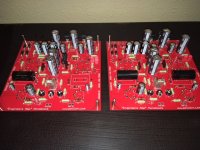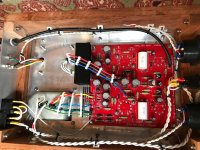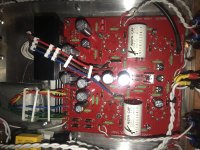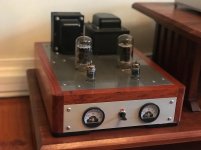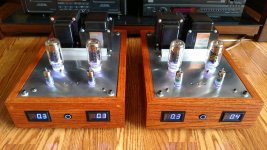Boards are finally finished minus one back ordered capacitor. Chassis should be here next week. Its been a fun project so far. The only deviation from Pete's design is the mundorf supreme .47uf capacitors and that is only because I had 3 on the shelf. Hopefully they do the trick.
I'll be driving a pair of Klipsh Chorus speakers. I know 50 watts sounds a little light for these but honestly, the little EL84 push pull amp (my first build) drives them pretty good at moderate to loud listening levels. I am thinking this should be quite a step up as far as output is concerned.
I'll be driving a pair of Klipsh Chorus speakers. I know 50 watts sounds a little light for these but honestly, the little EL84 push pull amp (my first build) drives them pretty good at moderate to loud listening levels. I am thinking this should be quite a step up as far as output is concerned.
Attachments
Wow this looks interesting. Putting aside the fun in building,
how does it sound compared to the likes of 6550/KT88 tubes ?
how does it sound compared to the likes of 6550/KT88 tubes ?
The only deviation from Pete's design is the mundorf supreme .47uf capacitors and that is only because I had 3 on the shelf.
Be sure to post your impressions.
I'll be driving a pair of Klipsh Chorus speakers. I know 50 watts sounds a little light for these but honestly, the little EL84 push pull amp (my first build) drives them pretty good at moderate to loud listening levels. I am thinking this should be quite a step up as far as output is concerned.
Aren't those speakers 101dB/watt/meter SPL? With 50 watts you're firmly into rock concert territory (like The Who).
jeff
I should have posted these earlier, I finished them about a year ago, but I have been fiddling around ever since.
In terms of sound, they are as described in the original engineers build, and by Pete himself on his website, on the original engineers page, they are fast and clear and have plenty of power.
I am using them to drive a pair of sunflower redux, and the pre-amp is a diy SRPP+ by a great local designer.
One thing I do have to say is that as per Pete's advice you should buy a stash of the 6HJ5, I had to mess around quite a bit to get a matching pair, even with biasing. You're also may want a few extra 500ma DC rated fuses.
For me pricing and shipping weight are an issue, my currency is weak against the USD. The OTP are from Edcor, and the Power Transformers are made to Hammond spec by a local company.
The enclosure, I designed in Autodesk 360, just wanted to mention that because the deserve it for the support they give to the maker community.
In terms of sound, they are as described in the original engineers build, and by Pete himself on his website, on the original engineers page, they are fast and clear and have plenty of power.
I am using them to drive a pair of sunflower redux, and the pre-amp is a diy SRPP+ by a great local designer.
One thing I do have to say is that as per Pete's advice you should buy a stash of the 6HJ5, I had to mess around quite a bit to get a matching pair, even with biasing. You're also may want a few extra 500ma DC rated fuses.
For me pricing and shipping weight are an issue, my currency is weak against the USD. The OTP are from Edcor, and the Power Transformers are made to Hammond spec by a local company.
The enclosure, I designed in Autodesk 360, just wanted to mention that because the deserve it for the support they give to the maker community.
Attachments
Just wondering why you didn't twist the output transformer plate and B+ leads to reduce parasitic coupling to other parts of the circuitry?
Short answer: because I got overly caught up in printing nonsensical parts on my 3D printer to try and solve the problem another way. But yes, you dug up a skeleton, and point taken.
Nice job on the Chassis. It was my intention to build something similar but I just do not have the tools to do the job right and I have a few OCD tendencies so these jobs take me a while lol.
I hope so. Yea I think they are rated for 101db. Sure doesn't seem take a lot of power to get decent levels out of them.
Will definitely share my impressions though I do not claim to be an audiophile by any means but I do enjoy the tube sound.
Will definitely share my impressions though I do not claim to be an audiophile by any means but I do enjoy the tube sound.
Sorry the pic of the actual enclosure was terrible.
Congrats, you did a nice job.

jeff
Quick question for you experts. How do you feel about using terminal blocks for connections to the pcb? I'm just thinking it would make it easier to to remove the board for repairs or mods in the future but I am concerned that it might degrade the sound a bit.
Hi all,
Just finished building this pair or monoblocks and powered them on for the 1st time this evening. Have an 8ohm dummy loan on the outputs and shorted the imputs. One amp is stable and ready for biasing and burn in. The dummy load on the other monoblock gets quite hot within 25 seconds of powering on and needs to be turned off. I swapped tubes between amps and same symptoms. With the tubes removed, the dummy load dosent get hot and allows me to check voltages. Voltages seem to be in the ballpark, but a bit high (tubes removed). Any advise as to how to troubleshoot this?
Just finished building this pair or monoblocks and powered them on for the 1st time this evening. Have an 8ohm dummy loan on the outputs and shorted the imputs. One amp is stable and ready for biasing and burn in. The dummy load on the other monoblock gets quite hot within 25 seconds of powering on and needs to be turned off. I swapped tubes between amps and same symptoms. With the tubes removed, the dummy load dosent get hot and allows me to check voltages. Voltages seem to be in the ballpark, but a bit high (tubes removed). Any advise as to how to troubleshoot this?
Did some more digging and double checked and all component values are correct, electrolytic caps in correct orientation, tube socket pins not shorted. With tubes removed, voltages between both amps are identical. Dummy load resistor starts smoking as soon as bias voltage starts rising.
Any luck finding the problem. My chassis just shipped so I will be doing final assembly this weekend so any advice would be appreciated.
kweaver,
I recently finished a pair and while I didn’t encounter the problems kstylianos saw, I did have a couple issues worth mentioning.
One of the two amps kept blowing a fuse. Not on first power on, but on the second. I’d turn it on and everything worked fine. But the next time I tried to turn it on, the fuse would blow. I addressed this problem by increasing the fuse value to, I think, 3.1A.
The other problem related to hum from the power transformers. This was purely mechanical hum and did not couple into the speakers. It was just the transformer vibrating on the chassis. I fixed this problem by adding some isolation washers I founds on amazon.
I’d also recommend paying close attention to the CAD drawings of the chassis. In particular notice the stand-off height between the PCB and the chassis top plate. If you use stand-offs too large, like I did, the tube sockets for the pre-tubes won’t be high enough and you won’t be able to seat the tubes in the sockets.
Now that I have things sorted, I’m quite happy with the end result - including some nice power switches with LED indicators I added to the front plate.
mike
I recently finished a pair and while I didn’t encounter the problems kstylianos saw, I did have a couple issues worth mentioning.
One of the two amps kept blowing a fuse. Not on first power on, but on the second. I’d turn it on and everything worked fine. But the next time I tried to turn it on, the fuse would blow. I addressed this problem by increasing the fuse value to, I think, 3.1A.
The other problem related to hum from the power transformers. This was purely mechanical hum and did not couple into the speakers. It was just the transformer vibrating on the chassis. I fixed this problem by adding some isolation washers I founds on amazon.
I’d also recommend paying close attention to the CAD drawings of the chassis. In particular notice the stand-off height between the PCB and the chassis top plate. If you use stand-offs too large, like I did, the tube sockets for the pre-tubes won’t be high enough and you won’t be able to seat the tubes in the sockets.
Now that I have things sorted, I’m quite happy with the end result - including some nice power switches with LED indicators I added to the front plate.
mike
Hi kweaver,
Terminal blocks will be fine as long as they are rated for the voltages they will see. I would normally use "barrier strips" with some fish paper (insulator) underneath so it can't arc. Thick plastic would also work. The sound will not be affected as the terminal block makes a very low resistance connection.
-Chris
Terminal blocks will be fine as long as they are rated for the voltages they will see. I would normally use "barrier strips" with some fish paper (insulator) underneath so it can't arc. Thick plastic would also work. The sound will not be affected as the terminal block makes a very low resistance connection.
-Chris
Sorry I did not follow up with my inquiry. The issue was I switched the NFB leads to the board. I used similar colored zip wire for the NFB and thought I had the polarity correct. Very simple mistake that cost me hours.
I burned them in on the bench for about 1.5 hours with 8-Ohm dummy load and inputs shorted. Continued needing to tweak bias current (55mA), but that finally settled down after 45 mins to an hour. Balance voltage pretty much stayed rock solid after 30 minutes. One of the input tubes went bad/microphonic and after replacement/rebiasing all has been well. Will continue to play them hard and check/adjust voltages as they settle in.
I'll second Mike's observations with the humming PT and making sure of correct standoff lengths. I haven't addressed the PT yet and will probably isolate from chassis as well. I cut my own out of standoffs from a spool of plastic tubing from Lowes.
An interesting phenomenon I'm noticing is that with a pair of Klipsch Heresy (8ohm) connected to either the 4 or 8-ohm tap, the bias current raises to ~70mA. This does not happen with my JMR 3ways (4ohm) or with the dummy load. Still need to figure this out.
Here's a pic with LED voltmeters turned on and amps warming up. I have some higher resolution meters on order.
I burned them in on the bench for about 1.5 hours with 8-Ohm dummy load and inputs shorted. Continued needing to tweak bias current (55mA), but that finally settled down after 45 mins to an hour. Balance voltage pretty much stayed rock solid after 30 minutes. One of the input tubes went bad/microphonic and after replacement/rebiasing all has been well. Will continue to play them hard and check/adjust voltages as they settle in.
I'll second Mike's observations with the humming PT and making sure of correct standoff lengths. I haven't addressed the PT yet and will probably isolate from chassis as well. I cut my own out of standoffs from a spool of plastic tubing from Lowes.
An interesting phenomenon I'm noticing is that with a pair of Klipsch Heresy (8ohm) connected to either the 4 or 8-ohm tap, the bias current raises to ~70mA. This does not happen with my JMR 3ways (4ohm) or with the dummy load. Still need to figure this out.
Here's a pic with LED voltmeters turned on and amps warming up. I have some higher resolution meters on order.
Attachments
If the current goes up when connecting a particular speaker, with no audio, it's likely that it is oscillating due to some reactive component of the load. Usually if you place a dummy resistor load of between 20 and 100 ohms across the output, it fixes it...
Pete
Pete
- Home
- Vendor's Bazaar
- 50W monoblock "Engineers Amp"
